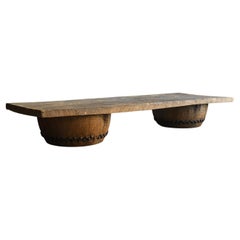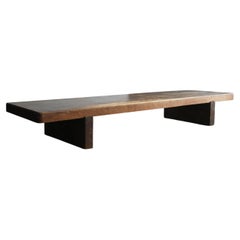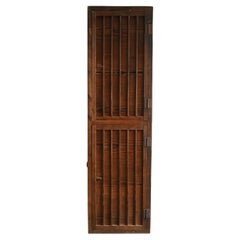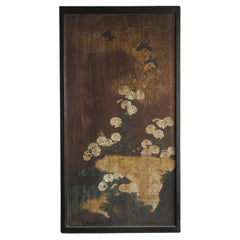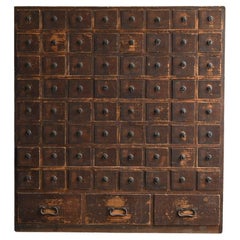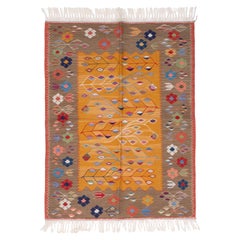Japan
to
548
998,839
696,422
2,306
1,395
906
443
416
364
307
167
143
110
99
88
87
68
57
55
48
47
47
41
29
21
14
12
9
7
7
7
6
6
5
5
4
4
4
3
3
2
2
2
1
1
1
1
1
1
1
314
201
77
50
45
Japanese antique large wooden low table / 1868 to 1920 / Wabi-sabi sofa table
Located in Sammu-shi, Chiba
This is a very special low table that combines an old Japanese large board with a table base made from repurposed traditional Japanese drums.
The top panel is made of cedar wood fro...
Category
Early 20th Century Japanese Meiji Japan
Materials
Cedar
Japanese antique long wooden low table/1868-1920/simple design sofa table
Located in Sammu-shi, Chiba
This is a wooden workbench from the first half of the 20th century in Japan, a piece with its stately construction and long history. Katsura and horse chestnut wood are used for the ...
Category
Late 19th Century Japanese Showa Antique Japan
Materials
Wood
Japanese antique wooden storage shelf/ Early 20th century/Wooden cabinet
Located in Sammu-shi, Chiba
This is a vertical wooden storage cabinet made of Japanese cedar in the first half of the 20th century. Although it is unknown where it was used, its appearance oozes a beauty that transcends practical use. The rustic feel of the material and its quiet presence give it a nostalgic warmth not found in modern furniture.
This piece is made entirely of solid Japanese cedar, and the simple and disciplined structure of the vertical cleats, especially on the doors, and the cedar planks passed horizontally and overlapping from the reverse side, bring a perfect balance and rhythm to the overall look of the piece. This kind of design reveals a uniquely Japanese sense of design.
The deep candy-colored texture created by the aging process is a taste that only antique pieces can have. The subtle changes in color from suntanning and areas touched by the hand tell a quiet story of the passage of time. The doors are simple and close with small wooden stoppers, preserving the practicality and warmth of the past.
The shelves are securely fastened and provide ample storage capacity. Books, clothes, daily necessities, and various other items can be beautifully organized. The backs and shelves are stained and worn from use, and there are also some holes repaired on the sides and small chips.
In a modern living space, this shelf can be used as a shelf in a study, as an accent in a living room, or as a quiet corner of a room where one spends quiet time alone, bringing a sense of calmness and flavor to the entire space. These long, locker-like proportions of antique shelves...
Category
Early 20th Century Japanese Taisho Japan
Materials
Cedar
A rare wooden sliding door with Japanese paintings/1800-1920/Edo-Meiji
Located in Sammu-shi, Chiba
This is a wooden sliding door produced in Japan from the late Edo period to the Meiji period. This piece, which must have watched over people's lives for many years, is more than jus...
Category
19th Century Japanese Edo Antique Japan
Materials
Cypress
Japanese antique wooden Medicine drawer/1868-1920/MINGEI/Meiji-Taisho
Located in Sammu-shi, Chiba
Introducing a cedar wood medicine chest (kusuri-dansu) made in Japan from the Meiji period to the early Showa period.
These chests were originally used by pharmacies and Chinese med...
Category
Late 19th Century Japanese Meiji Antique Japan
Materials
Cedar
New Konya Fine Modern Kilim Central Anatolian Rug Turkish Carpet
Located in Tokyo, JP
This is a Central Anatolian Modern 'New' Fine Kilim from the Konya region with a rare and beautiful color composition.
As early as the 13th century Marco Polo noted, in his account...
Category
2010s Turkish Kilim Japan
Materials
Wool, Natural Fiber
Japanese Antique Low Drawer 1860s-1900s / Tansu Storage Wabisabi
Located in Sammu-shi, Chiba
This is a very old Japanese-made drawer storage.
This is from the Meiji period (1860s-1900s).
The material is mainly cedar.
The handles are made of iron.
Some of them are missing the...
Category
Early 20th Century Japanese Meiji Japan
Materials
Cedar
Japanese antiques wood table /wabi-sabi table / primitive wood table /
Located in Sammu-shi, Chiba
The table is made by combining an old Japanese stump with a newly made tabletop.
The wooden tabletop is an irregular oval shape and is painted with cashew paint, which is used as a ...
Category
Mid-20th Century Japanese Primitive Japan
Materials
Wood
Small stone carved rabbit statue / 19th-mid 20th century / Around Korea
Located in Sammu-shi, Chiba
This is a carved stone figurine of a rabbit with a unique design not found in old Japanese stone statues. From the taste of the shape, we can infer that it was made in Korea from the...
Category
Early 20th Century South Korean Other Japan
Materials
Stone
Japanese antique wooden low table/1868-1920/Wabi-sabi coffee table
Located in Sammu-shi, Chiba
This item is a stately Wabisabi wooden low table with a wooden box from the end of the Edo period to the Meiji period (1800-1912) in Japan as the table base, combined with an old oak...
Category
Late 19th Century Japanese Meiji Antique Japan
Materials
Oak
Japanese Antique Black Drawer / Storage Tansu / 1868s / Wabi-Sabi Mingei
Located in Iwate-gun Shizukuishi-cho, Iwate Prefecture
This is an old Japanese drawer.
The material is made of cedar, and the drawer has traces of "Meiji 1st year" (1868) written in ink at that time.
Over time, black soot has turned in...
Category
1860s Japanese Meiji Antique Japan
Materials
Iron
Cartier 1895 Solitaire 0.40 Carat Solitaire Diamond Ring Pt 50 US 5.0
By Cartier
Located in Kobe, Hyogo
Item: Authentic Cartier 1895 Diamond Solitaire Ring
Stones: Diamond (0.40ct)
Color: F
Clarity: VS2
Polish: Excellent
Symmetry: Excellent
Fluorescence: None
Metal: Platinum 950
Ring S...
Category
2010s French Japan
Materials
Diamond, Platinum
Japanese Antique Tansu 1920s-1940s / Bamboo decoration / cabinet
Located in Sammu-shi, Chiba
This is a very old Japanese cabinet.
It dates from the early Showa period (1920s-1940s).
It is made of cedar.
It is decorated with bamboo and has a traditional Japanese design.
B...
Category
Early 20th Century Japanese Showa Japan
Materials
Cedar
New Manisa Fine Handwoven Modern Kilim West Anatolian Rug Turkish Wool Carpet
Located in Tokyo, JP
This is a Western Anatolian Modern 'New' Fine Kilim from the Manisa region with a rare and beautiful color composition.
This kilim is woven according to traditional kilim technique...
Category
2010s Turkish Kilim Japan
Materials
Wool, Natural Fiber
Ararat Rugs Village Theme Azeri Folk Life Rug, Turkish Carpet, Natural Dyed
By Ararat Rugs
Located in Tokyo, JP
Introducing the Village Theme Azeri Folk Art Rug from Ararat Rugs, a vibrant testament to the rich weaving traditions of northeastern Turkey. Handcrafted by skilled Azeri and Kurdish...
Category
21st Century and Contemporary Turkish Oushak Japan
Materials
Wool, Natural Fiber, Organic Material
New Manisa Fine Handwoven Modern Kilim West Anatolian Rug Turkish Wool Carpet
Located in Tokyo, JP
This is a Western Anatolian Modern 'New' Fine Kilim from the Manisa region with a rare and beautiful color composition.
This kilim is woven according to traditional kilim technique...
Category
2010s Turkish Kilim Japan
Materials
Wool, Natural Fiber
Japanese Antique BK Middle Drawer 1860s-1900s / Tansu Storage Wabisabi
Located in Sammu-shi, Chiba
This is a very old Japanese black drawer storage.
The furniture is from the Meiji period (1860s-1900s).
It is probably from the Tohoku region of Japan.
The material is mainly cedar w...
Category
Early 20th Century Japanese Meiji Japan
Materials
Cedar
Circa 1700 Japanese Sliding Door (Fusuma) Set. Pine Trees on the Seashore.
Located in Kyoto, JP
"Pine Trees on the Seashore"
A set of four sliding doors (Japanese fusuma). Ink, color, gold-leaf and gold-fleck on paper.
Dimensions (total display si...
Category
Late 17th Century Japanese Edo Antique Japan
Materials
Gold Leaf
Ararat Rugs Kerman Vase Technique Carpet 17th Century Revival Rug, Natural Dyed
By Ararat Rugs
Located in Tokyo, JP
Introducing the exquisite Kerman Vase-Technique Carpet from Ararat Rugs, a masterful revival of the renowned 16th-century Sickle-Leaf carpets, such as the one housed in the Gulbenkia...
Category
21st Century and Contemporary Turkish Revival Japan
Materials
Wool, Natural Fiber, Organic Material
Hiroyuki Nishimura Sculptural bench 1 Tribal Style
By Hiroyuki Nishimura
Located in Shibuya-ku, Tokyo
Weighing Worlds
Sculptural bench
Material: Zelkova
This work is carved from log with some kinds of chainsaws.
Most of wood used for his works are unable to use anything, these woods...
Category
2010s Japanese Tribal Japan
Materials
Wood
Japanese Antique BK Drawer 1860s-1900s / Tansu Storage Wabisabi
Located in Sammu-shi, Chiba
This is a very old Japanese black drawer storage.
The furniture is from the Meiji period (1860s-1900s).
It is probably from the Tohoku region of Japan.
The material is mainly cedar w...
Category
Early 20th Century Japanese Meiji Japan
Materials
Cedar
Antique Chinese Pottery 【Luzon Jar】/Iron-glazed teapot/15th to 18th centuries
Located in Sammu-shi, Chiba
This is an antique ceramic jar, commonly known as a “Luzon Jar,” made sometime between the 15th and 18th centuries. It is believed to have been produced in southern China and then us...
Category
16th Century Chinese Other Antique Japan
Materials
Pottery
Japanese Antique Large Black Tansu / Cabinet Sideboard / 1868-1912s Wabi-sabi
Located in Iwate-gun Shizukuishi-cho, Iwate Prefecture
This is an old Japanese cabinet.
It was used in the Tohoku region of Japan around the Meiji period, and the main parts are all made of cedar. It is a light and easy-to-handle size.
...
Category
Late 19th Century Japanese Meiji Antique Japan
Materials
Wood, Cedar
Japanese Antique Wooden CoffeeTable / SideTable / 1868-1912s Wabi-sabi Primitive
Located in Iwate-gun Shizukuishi-cho, Iwate Prefecture
This is a coffee table made from an old Japanese mortar.
There are traces that Zelkova was used and are thought to have been hand-carved using tools.
Expressions made by human hand...
Category
Late 19th Century Japanese Primitive Antique Japan
Materials
Hardwood, Wood
Japanese wooden wabi-sabi board/Early 20th century/Display stand/MINGEI
Located in Sammu-shi, Chiba
This is an old wooden work board called a “Kate-Kiri-Ban,” which was used in the Aizu region of Fukushima Prefecture, Japan, around the early 20th century. The name breaks down as fo...
Category
Early 20th Century Japanese Taisho Japan
Materials
Chestnut
Semi Old Vintage Handwoven Wool Mut Kilim Central Anatolian Rug Turkish Carpet
Located in Tokyo, JP
This is a South Anatolian Vintage / Semi-old Handwoven Kilim from the town of Mut in Mersin Province, located in the Mediterranean region of Anatolia, Turkey. These kilims are renown...
Category
Late 20th Century Turkish Kilim Japan
Materials
Wool, Cotton, Natural Fiber
Ararat Rugs Akstafa Kazak Rug - 19th C. Caucasian Revival Carpet Natural Dyed
By Ararat Rugs
Located in Tokyo, JP
Origin and Inspiration:
This stunning revival of the Akstafa Kazak Rug is a modern creation deeply rooted in the rich weaving traditions of the Caucasus, specifically inspired by the...
Category
21st Century and Contemporary Turkish Revival Japan
Materials
Wool, Natural Fiber, Organic Material
Japanese Antique Low Table / Coffee Table / 1868-1912s / Wabi-sabi Mingei
Located in Iwate-gun Shizukuishi-cho, Iwate Prefecture
This is an old Japanese low table.
It was used for reading and writing in Terakoya in the Edo and Meiji periods.
On the back, there is a trace that seems to be the letters of that ...
Category
Late 19th Century Japanese Meiji Antique Japan
Materials
Wood, Cedar
Japanese Antique Red and Black Tansu / Cabinet / 1868-1912s / Wabi-Sabi Mingei
Located in Iwate-gun Shizukuishi-cho, Iwate Prefecture
This is an old cabinet called " Tansu" in Japan.
It is a lower type than a normal Tansu.
The original red color was used for a long time in an old house with a hearth, so it turned...
Category
Late 19th Century Japanese Meiji Antique Japan
Materials
Iron
Japanese antique wooden black low table / 1850-1912 / Edo-Meiji
Located in Sammu-shi, Chiba
I have just received a very attractive Japanese low table.
This is a wooden writing desk made between the end of the Edo period and the Meiji period. A writing desk is a small table ...
Category
Late 19th Century Japanese Edo Antique Japan
Materials
Cedar
18th Century Japanese Rinpa Screen. White Chrysanthemums. School of Korin.
Located in Kyoto, JP
School of Ogata Korin
White Chrysanthemums
18th Century, Edo period.
A two-panel Japanese screen. Ink, color, gofun and gold leaf on paper.
Dimensions: H. 171 cm x W. 188 cm (67.5” x 74”)
On this two-panel Japanese screen we see blooming chrysanthemums, a flower which embodies the essence of autumn in Japan. Here the traditional floral theme has been simplified and stylized. The bright colors and asymmetrical composition against the delicate gold leaf create a luxurious and ornate work of art. Its background, a strikingly patinated grid of gold leaf, denies any sense of place or time and imbues everything with an ethereal glow. The leaves and stems of the plants are nothing more than pools of mottled color and ink without any outline whatsoever. These are typical Rinpa adaptations of traditional ink painting methods; tarashikomi, or diluted washes of color blended while very wet, and mokkotsu, or “bonelessness,” which creates forms without exterior outlines. The relief work of the rounded flower petals has been obtained by the moriage process (a mixture based on ground shells modeled on the surface of the paper).
On the lower right of the screen, the siganture “Hokyo Korin Jakumyo” and the “Hoshuku” seal can be read. Korin is Ogata Korin, famed for the Irises (Nezu Museum) and Red and White Plum Blossom (MOA Museum of Art) folding screens, both National Treasures. Korin worked in both Kyoto and Edo in the mid-Edo period. Korin was using the art name “Jakumyo” just after he received the Hokyo level, which was in 1701.
This particular screen was published in May of 1961 in the Japanese Sansai Fine Art Magazine*. An in depth article accompanies the photograph of the screen and and a photograph of the signature and seal. This article devotes much of its body to discussing the moriage technique, how it enlivens the chrysanthemum flowers and Korin’s specific skill in using the technique. The article goes on to discuss the most famous works of Korin, utilizing this technique, which were known at the time. Specifically a two-panel screen held in the Honolulu Museum which was discovered in the store-house of Takahashi Soan. A two-panel screen pair which the Nakano family own. A two-panel screen pair with chrysanthemums in moriage in fan designs owned by the Nomura family. Also a small folding screen featuring chrysanthemums held in the Yamato Bunkakan. The article goes on to say that this particular two-fold screen came from the Nijo family. Korin is known to have had a strong connection with the aristocratic Nijo family. The article explains that Korin received a lot of favors from the Nijo family and that this screen would have been gifted to them.
Since that time the Honolulu screen has been amended to ‘attributed to Ogata Korin’ and I do not know further details of the other 3 screens. Other Chrysanthemum screens...
Category
18th Century Japanese Edo Antique Japan
Materials
Gold Leaf
Japanese Antique Black Tansu / Cabinet Storage / 1868-1912s / Wabi-Sabi Mingei
Located in Iwate-gun Shizukuishi-cho, Iwate Prefecture
This is an old black cabinet called " Tansu" in Japan.
It was used in the Tohoku region of Japan around the Meiji period and was placed in the attic of a thatched-roofed house for a...
Category
Late 19th Century Japanese Meiji Antique Japan
Materials
Iron
Japanese Antique Tansu 1860s-1920s / Chest of Drawer Wabi Sabi
Located in Sammu-shi, Chiba
This is a very old chest of drawers made in Japan.
This piece of furniture dates back to the Meiji period (1860s-1920s).
The main material is cedar, with chestnut wood used only for...
Category
Early 20th Century Japanese Meiji Japan
Materials
Chestnut, Cedar
Japanese antique wooden drawers/1868-1920/tasteful chest
Located in Sammu-shi, Chiba
This is a wooden drawer made of cedar wood from the Meiji and Taisho periods (circa 1868-1920) in Japan.
The warm texture peculiar to cedar wood stands out, and the rustic simplicit...
Category
Late 19th Century Japanese Meiji Antique Japan
Materials
Cedar
Old Japanese black maneki-neko object / 20th century / lucky ornament
Located in Sammu-shi, Chiba
Here is a Japanese "Maneki Neko" (beckoning cat) figurine from the Showa era. It is made from either clay or plaster and features a simple yet impactful design. On the back, you can ...
Category
20th Century Japanese Showa Japan
Materials
Plaster, Clay
Japanese wooden low table/20th century/exhibition table
Located in Sammu-shi, Chiba
This unique low table is a combination of an old Japanese wooden board and an old iron ball. Softwoods such as pine are used for the top board, and it has a solid weight of 29.65 kg,...
Category
20th Century Japanese Showa Japan
Materials
Iron
Simple design old wooden bed/20th century/low table/wooden low bench
Located in Sammu-shi, Chiba
This is a traditional wooden bench, the exact country of origin is unclear, but it likely comes from Southeast Asia or Africa, with particular similarities to the furniture of the Se...
Category
20th Century Southeast Asian Other Japan
Materials
Wood
Japanese "Suiseki" Mountain View Scholar's Old Large Stone /Mountain Scenery
Located in Sammu-shi, Chiba
This is a stone mined in Japan.
Not only in China but also in Japan from ancient times, rocks in the mountains have been shaved and stones for viewing have been quarried.
It is a ve...
Category
20th Century Japanese Showa Japan
Materials
Limestone
Japanese Antique Pottery Vase 1185s-1333s / Tsubo Wabisabi
Located in Sammu-shi, Chiba
This account is operated by four different companies.
As for me, I specialize in Japanese antiques and carefully selected items.
With my 20 years of experience, I am re-proposing Jap...
Category
15th Century and Earlier Japanese Other Antique Japan
Materials
Pottery
Japanese old wood stand / Exhibition stand wabi-sabi / primitive wood stand /
Located in Sammu-shi, Chiba
This display stand is made by combining old wooden sleepers with a newly made tabletop.
The top of the display stand is finished with cashew paint, like lacquer, and has a jet blac...
Category
Mid-20th Century Japanese Primitive Japan
Materials
Wood
Japanese antique wooden low table/"Fuzukue"/19th century/Meiji to Taisho period
Located in Sammu-shi, Chiba
This writing desk is an antique piece from the Meiji to Taisho periods of Japan, crafted using the luxurious wood of keyaki (zelkova). The desk features the signature "takenoko-moku"...
Category
19th Century Japanese Meiji Antique Japan
Materials
Wood
Japanese Wabi Sabi Antique Wooden Low Table/1800-1920/Sofa Table
Located in Sammu-shi, Chiba
This is a low table made from a part of a rare wooden ship “Kitamae-bune” obtained in Kanazawa, Hokuriku region. Kitamae-bune was an important trading ship that connected northern an...
Category
19th Century Japanese Meiji Antique Japan
Materials
Oak, Pine
Semi Old Vintage Handwoven Wool Mut Kilim Central Anatolian Rug Turkish Carpet
Located in Tokyo, JP
This is a South Anatolian Vintage / Semi-old Handwoven Kilim from the town of Mut in Mersin Province, located in the Mediterranean region of Anatolia, Turkey. These kilims are renown...
Category
Late 20th Century Turkish Kilim Japan
Materials
Wool, Cotton, Natural Fiber
Japanese wood table /wabi-sabi table / primitive table / exhibition stand
Located in Sammu-shi, Chiba
This table has a wabi-sabi feel and is made from driftwood.
The base of the table is made from the same wood and has three legs, making it very strong and sturdy. The surface has ag...
Category
21st Century and Contemporary Japanese Primitive Japan
Materials
Wood
Japanese Antique Large BK Tansu 1860s-1900s / Cabinet Sideboard Wabi Sabi
Located in Sammu-shi, Chiba
This chest of drawers is a rare piece with a good overall construction, with linear decorations on the doors.
Judging from the metal parts, it seems to be quite old. Since the origin...
Category
Early 20th Century Japanese Edo Japan
Materials
Cedar
Japanese Antique Black Drawer With Paper Pasted / Storage/ 1868-1912s/ Wabi-sabi
Located in Iwate-gun Shizukuishi-cho, Iwate Prefecture
This is an old Japanese black chest.
It seems to be around the Meiji period, and the material is made of cedar.
Old paper is attached to the sides, back, and top. The paper is past...
Category
Late 19th Century Japanese Meiji Antique Japan
Materials
Iron
Japanese Antique Drawer 1860s-1900s / Storage Tansu Wabisabi
Located in Sammu-shi, Chiba
This is a very old Japanese small drawer storage.
The furniture is from the Meiji period (1860s-1900s).
This is a "Shonai chest" chest made in the Tohoku region of Japan.
It is chara...
Category
Early 20th Century Japanese Meiji Japan
Materials
Cedar
Antique Japanese tall & thick Urushi wooden sliding doors, wabi sabi primitive
Located in 常陸大宮市, JP
New finds from the main hall of an Buddhist temple in Ibaraki pref., Japan
***
We're eco-friendly, organic-oriented vintage wood furniture & fitting seller.
Avoiding the harsh che...
Category
Late 19th Century Japanese Edo Antique Japan
Materials
Wood
Japanese Antique Large Tansu 1860s-1920s / Sideboard Wabisabi
Located in Sammu-shi, Chiba
This account is operated by five different companies.
As for me, I specialize in Japanese antiques and carefully selected items.
With my 20 years of experience, I am re-proposing Jap...
Category
Early 20th Century Japanese Meiji Japan
Materials
Cedar
Japanese Antique Chest of Drawer 1860s-1920s / Tansu Wabi Sabi
Located in Sammu-shi, Chiba
This account is operated by five different companies.
I, on the other hand, specialize in Japanese antiques and selected items.
With 20 years of experience, I am re-proposing Japanes...
Category
Early 20th Century Japanese Meiji Japan
Materials
Iron
Vintage & Old Kilim Cushion Cover, Anatolian Yastik Turkish Modern Pillow 4361
Located in Tokyo, JP
We made a cushion cover using the undamaged parts of the precious and high-quality old & antique kilims that cannot be repaired. Like a painting, a part of the scenery is cut out fro...
Category
2010s Turkish Kilim Japan
Materials
Natural Fiber, Organic Material
Old Japanese wooden rabbit figurine/20th century/carved animal
Located in Sammu-shi, Chiba
This is a wooden rabbit made in the Taisho to Showa eras (20th century) in Japan.
The sculptor's name is engraved on the bottom, and it seems to have been carved by a person named "O...
Category
20th Century Japanese Taisho Japan
Materials
Wood
Japanese Antique Black Tansu / Drawer Cabinet Storage / 1868-1912s Wabi-Sabi
Located in Iwate-gun Shizukuishi-cho, Iwate Prefecture
This is an old black cabinet in Japan, which is called a "tansu" in Japan.
It seems to be around the Meiji period, and the material is made of cedar.
The drawers are wide on the si...
Category
Late 19th Century Japanese Meiji Antique Japan
Materials
Iron
Japanese Antique BK Small Drawer 1860s-1900s / Tansu Storage Wabisabi
Located in Sammu-shi, Chiba
This is a very old Japanese black drawer storage.
The furniture is from the Meiji period (1860s-1900s).
It is probably from the Tohoku region of Japan.
The material is mainly cedar w...
Category
Early 20th Century Japanese Meiji Japan
Materials
Cedar
Japanese Antique Large Tansu 1860s-1900s / Sideboard Wabi Sabi
Located in Sammu-shi, Chiba
This is a historically significant Japanese tansu (chest) from the Meiji era (1860s–1900s), crafted from cedar wood.
Its minimalist and refined design embodies traditional Japanese ...
Category
Late 19th Century Japanese Meiji Antique Japan
Materials
Cedar
Japanese antiques wood table /wabi-sabi side table / primitive wood table / stan
Located in Sammu-shi, Chiba
This table is made by combining old Japanese stumps and boards. Its small size means it can also be used as a side table or stand.
The tree stump that serves as the base of the tabl...
Category
Mid-20th Century Japanese Primitive Japan
Materials
Wood
Japanese Antique Large Tansu 1860s-1900s / Sideboard Wabi Sabi
Located in Sammu-shi, Chiba
This is a historically significant Japanese tansu (chest) from the Meiji era (1860s–1900s), crafted from cedar wood.
Its minimalist and refined design embodies traditional Japanese ...
Category
Late 19th Century Japanese Meiji Antique Japan
Materials
Cedar
Japanese Antique Large Tansu / Cabinet Sideboard / 1868-1912s Wabi-sabi
Located in Iwate-gun Shizukuishi-cho, Iwate Prefecture
This is an old Japanese cabinet.
It is estimated that it was around the Meiji period, and the main parts are all made of zelkova. It is speculated that everything made of zelkova wa...
Category
Late 19th Century Japanese Meiji Antique Japan
Materials
Iron
Japanese Wooden block table /wabi-sabi coffee table/1900s〜
Located in Sammu-shi, Chiba
About
This table was made from a mortar that was used to pound rice cakes in ancient times.
The mortar made from Zelkova wood is very heavy and sturdy.
Rather than being shaped like...
Category
Early 20th Century Japanese Primitive Japan
Materials
Wood
Antique Japanese woven wall hanging basket/20th century/Wabi-sabi vase
Located in Sammu-shi, Chiba
This is a rustic woven basket made of walnut bark, made in Japan around the 20th century.
In Japan, tools made of natural materials have been used since ancient times as baskets for ...
Category
20th Century Japanese Taisho Japan
Materials
Wood
